 Technology peripherals
Technology peripherals
 AI
AI
 Vincent's 3D model breakthrough! MVDream is coming, generating ultra-realistic 3D models in one sentence
Vincent's 3D model breakthrough! MVDream is coming, generating ultra-realistic 3D models in one sentence
Vincent's 3D model breakthrough! MVDream is coming, generating ultra-realistic 3D models in one sentence
This is incredible!
Now you can easily create beautiful and high-quality 3D models with just a few words?
No, a foreign blog set off the Internet and put something called MVDream in front of us.
Users can create a lifelike 3D model with just a few words.
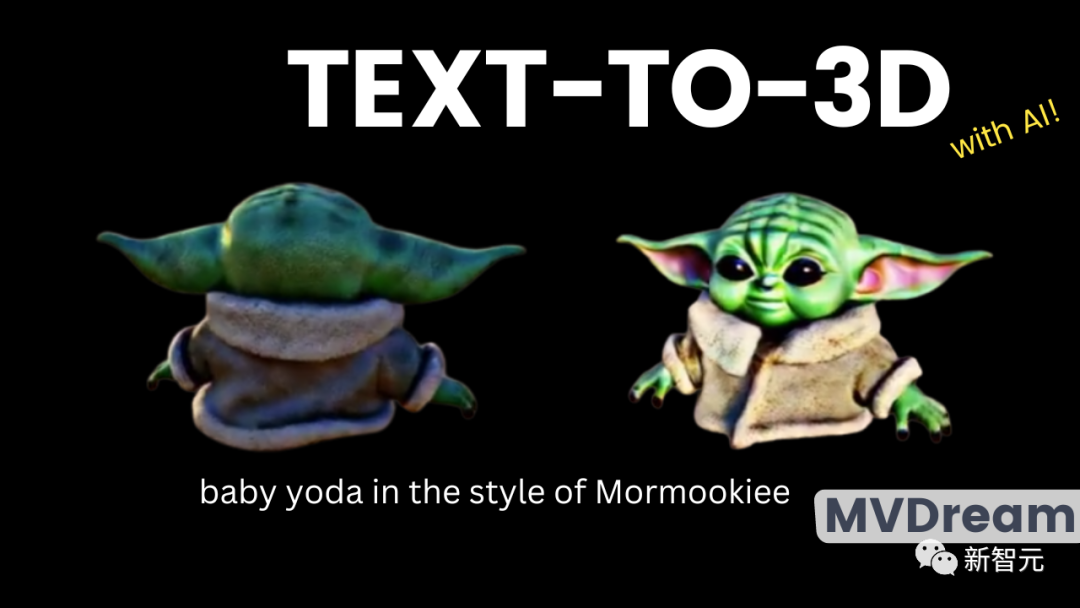
And what’s different from before is that MVDream seems to really “understand” physics.
Let’s see how amazing this MVDream is~
MVDream
小Brother said that in the era of big models, we have seen too many text generation models and image generation models. And the performance of these models is getting more and more powerful.
We later witnessed the birth of the Vincent video model, and of course the 3D model we want to mention today
Just imagine, just Just input a sentence, and you can generate an object model that looks like it exists in the real world, even including all the necessary details. How cool is this scene?
And this is definitely not a It’s a simple thing, especially when users need to generate models that are realistic enough in detail.
Let’s take a look at the effect first~

##At the same time As a reminder, what is shown on the far right is the finished product of MVDream
The gap between the 5 models is visible to the naked eye. The first few models completely violate the objective facts and are only correct when viewed from certain angles.
For example, in the first four pictures, the generated model actually has more than two ears. Although the fourth picture looks more detailed, when turned to a certain angle we can find that the character's face is concave and there is an ear stuck on it.
Who knows, the editor immediately remembered the front view of Peppa Pig, which was very popular before.
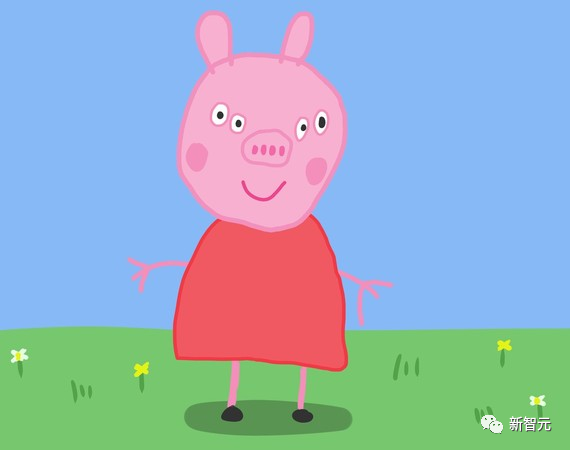
This is a situation that is shown to you from certain angles, but absolutely not from other angles, there will be Life danger
But the generation model of MVDream on the far right is obviously different. No matter how the 3D model is rotated, you will not feel anything unconventional.
This is what was mentioned before, MVDream knows the physics knowledge well and will not create some weird things just to ensure that each view has two ears
The brother pointed out that the key to judging whether a 3D model is successful is to observe whether its different perspectives are realistic and of high quality
And also ensure that the model is in space continuity, rather than the multiple ears model above.
One of the main methods of generating 3D models is to simulate the camera's perspective and then generate what can be seen from a certain perspective.
In other words, this is the so-called 2D lifting. It means splicing different perspectives together to form the final 3D model.
The above multi-ear situation occurs because the generative model does not fully grasp the shape information of the entire object in the three-dimensional space. And MVDream is just a big step forward in this regard.
This new model solves the previous consistency problem in 3D perspective
Fractional distillation sampling
This method is called score distillation sampling and was developed by DreamFusion
Before we start learning about fractional distillation sampling technology, we need to understand it first Let’s take a look at the architecture used in this method
In other words, this is actually just another two-dimensional image diffusion model, similar to the DALLE, MidJourney and Stable Diffusion models
More specifically, everything starts from the pre-trained DreamBooth model. DreamBooth is an open source model based on Stable Diffusion raw graphs.
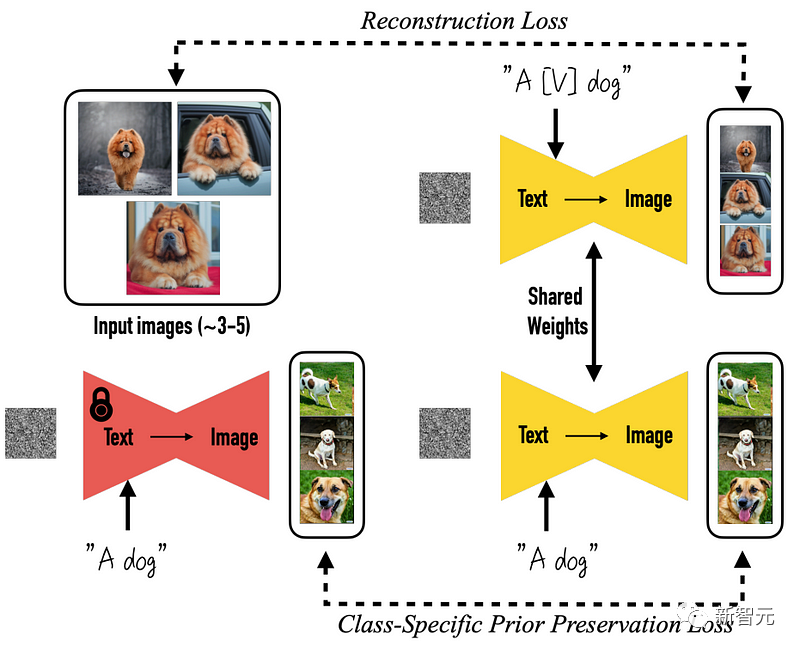
Change is coming, which means things have changed
What the research team did next Yes, directly rendering a set of multi-view images instead of just rendering one image. This step requires three-dimensional data sets of various objects to complete.
Here, the researchers took multiple views of a 3D object from a dataset, used them to train a model, and then used it to generate those views backwards.
The specific method is to change the blue self-attention block in the picture below to a three-dimensional self-attention block. That is to say, the researchers only need to add one dimension to reconstruct multiple images, and Not an image.
In the picture below, we can see that the camera and timestep are input into the model for each view to help the model understand which image will be used where, and what is needed What kind of view is generated
Now, all the images are connected together and the generation is also done together. So they can share information and better understand the big picture.
First, text is input into the model, and then the model is trained to accurately reconstruct objects from the data set
And here is where the research team applied more A place to view the fractional distillation sampling process.
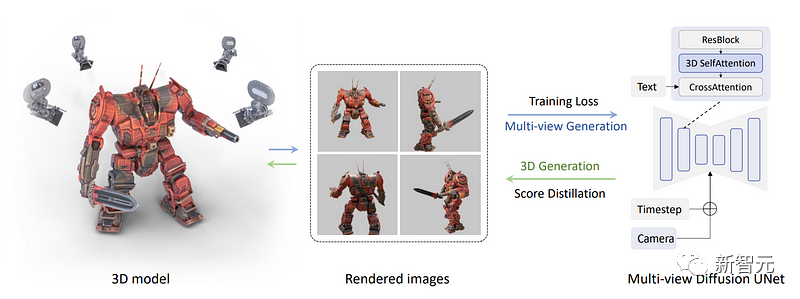
Now, with a multi-view diffusion model, the team can generate multiple views of an object.
Next, we need to use these views to reconstruct a three-dimensional model that is consistent with the real world, not just the views
Needed here This is achieved using NeRF (neural radiance fields), just like the aforementioned DreamFusion.
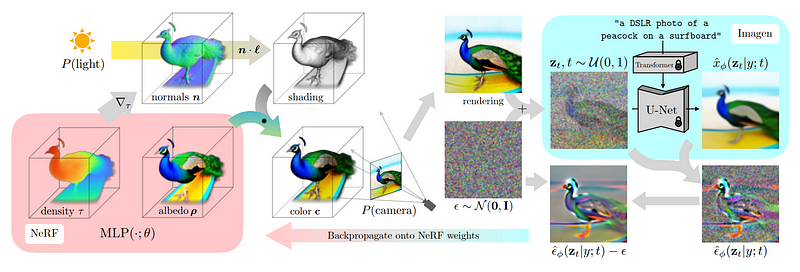
In this step, our goal is to freeze the previously trained multi-view diffusion model. In other words, we just use the pictures from each perspective above in this step without training.
Under the guidance of the initial rendering, the researchers began to use the multi-view diffusion model to generate Some noisy versions of the initial image
To let the model know that it needs to generate different versions of the image, the researchers added noise while still being able to receive background information
Next, this model can be used to further generate higher quality images
Add the image used to generate this image and remove the image we added manually noise so that the results can be used in the next step to guide and improve the NeRF model.
In order to generate better results in the next step, the purpose of these steps is to better understand which part of the image the NeRF model should focus on
Repeat this process until a satisfactory 3D model is generated
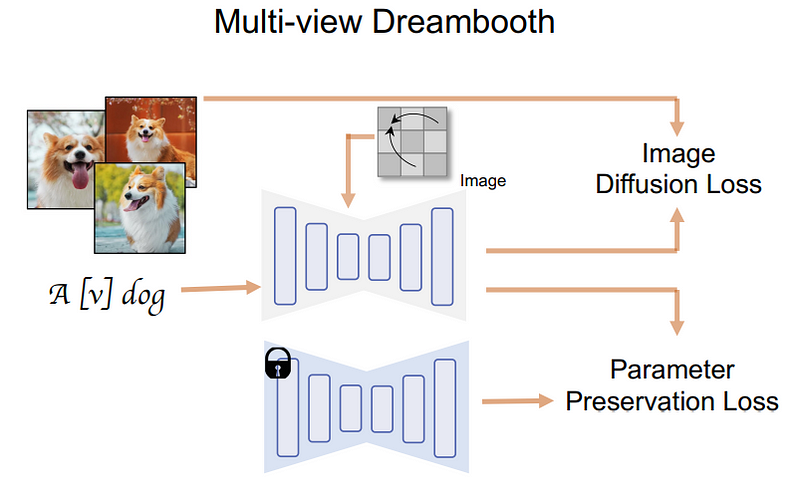
And for multiple perspectives This is how the team evaluated the image generation quality of the diffusion model and judged how different designs would affect its performance.
First, they compared choices of attention modules for building cross-view consistency models.
These options include:
(1) One-dimensional temporal self-attention widely used in video diffusion models;
(2) Add a new three-dimensional self-attention module to the existing model;
(3) Reuse the existing two-dimensional self-attention module for three-dimensional attention .
In order to accurately demonstrate the differences between these modules, in this experiment, the researchers used 8 frames of 90-degree perspective changes to train the model to more closely match the video settings
In the experiment, the research team also maintained a higher image resolution, that is, 512×512 as the original SD model. As shown in the figure below, the researchers found that even with such limited perspective changes in static scenes, temporal self-attention is still affected by content shifts and cannot maintain perspective consistency
The team hypothesizes that this is because temporal attention can only exchange information between the same pixels in different frames, while the corresponding pixels may be far apart when the viewpoint changes.
On the other hand, adding new 3D attention without learning consistency can lead to severe quality degradation.
The researchers believe that this is because learning new parameters from scratch will consume more training data and time, which is not applicable to this situation where the three-dimensional model is limited. They proposed a strategy to reuse the 2D self-attention mechanism to achieve optimal consistency without degrading the generation quality
The team also noted that if the image size is reduced to 256 , the number of views is reduced to 4, and the differences between these modules will be much smaller. However, to achieve the best consistency, the researchers made their choices based on preliminary observations in the following experiments.
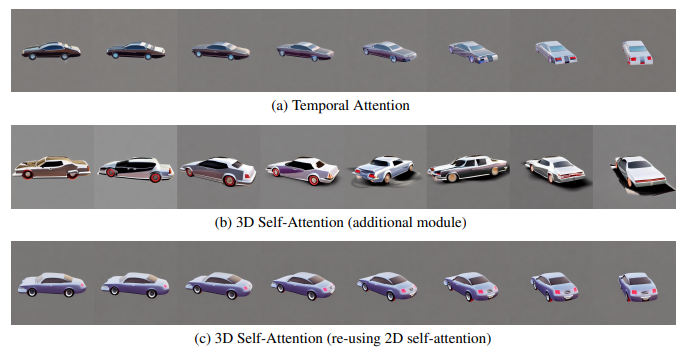
In addition, the researchers implemented multi-view fractional distillation sampling in the threestudio (thr) library and introduced multi-view diffusion guidance. This library implements state-of-the-art text-to-3D model generation methods under a unified framework
The researchers used the implicit-volume in threestudio as the 3D representation. implementation, including a multi-resolution hash-grid
When studying the camera view, the researchers used exactly the same approach when rendering the 3D dataset Two people were sampled on the camera
In addition, the researchers also optimized the 3D model for 10,000 steps, using the AdamW optimizer and setting the learning rate to 0.01
In fractional distillation sampling, in the first 8000 steps, the maximum and minimum time steps are reduced from 0.98 steps to 0.5 steps and 0.02 steps respectively
The starting resolution of rendering is 64×64, which gradually increases to 256×256 after 5000 steps
The following are more cases:
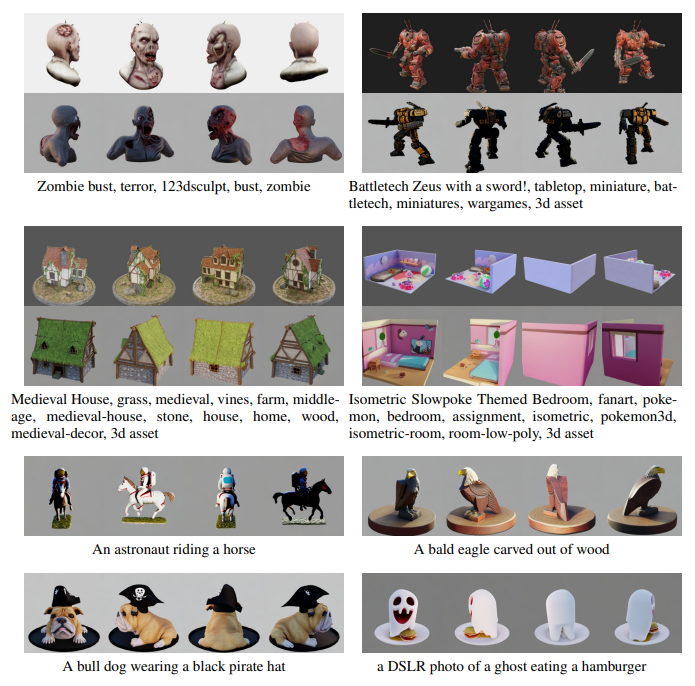
The research team used a 2D text-to-image model to perform multi-view synthesis, and through an iterative process, created a text-to-3D model method
This new method currently has some limitations. The main problem is that the resolution of the generated image is only 256x256 pixels, which can be said to be very low.
In addition, the researchers It was also pointed out that the size of the data set used to perform this task will certainly limit the generalizability of this method to some extent, because if the data set is too small, it will not be able to reflect our complex world more realistically.
The above is the detailed content of Vincent's 3D model breakthrough! MVDream is coming, generating ultra-realistic 3D models in one sentence. For more information, please follow other related articles on the PHP Chinese website!

Hot AI Tools

Undresser.AI Undress
AI-powered app for creating realistic nude photos

AI Clothes Remover
Online AI tool for removing clothes from photos.

Undress AI Tool
Undress images for free

Clothoff.io
AI clothes remover

Video Face Swap
Swap faces in any video effortlessly with our completely free AI face swap tool!

Hot Article

Hot Tools

Notepad++7.3.1
Easy-to-use and free code editor

SublimeText3 Chinese version
Chinese version, very easy to use

Zend Studio 13.0.1
Powerful PHP integrated development environment

Dreamweaver CS6
Visual web development tools

SublimeText3 Mac version
God-level code editing software (SublimeText3)

Hot Topics
 1393
1393
 52
52
 1207
1207
 24
24
 Use ddrescue to recover data on Linux
Mar 20, 2024 pm 01:37 PM
Use ddrescue to recover data on Linux
Mar 20, 2024 pm 01:37 PM
DDREASE is a tool for recovering data from file or block devices such as hard drives, SSDs, RAM disks, CDs, DVDs and USB storage devices. It copies data from one block device to another, leaving corrupted data blocks behind and moving only good data blocks. ddreasue is a powerful recovery tool that is fully automated as it does not require any interference during recovery operations. Additionally, thanks to the ddasue map file, it can be stopped and resumed at any time. Other key features of DDREASE are as follows: It does not overwrite recovered data but fills the gaps in case of iterative recovery. However, it can be truncated if the tool is instructed to do so explicitly. Recover data from multiple files or blocks to a single
 Open source! Beyond ZoeDepth! DepthFM: Fast and accurate monocular depth estimation!
Apr 03, 2024 pm 12:04 PM
Open source! Beyond ZoeDepth! DepthFM: Fast and accurate monocular depth estimation!
Apr 03, 2024 pm 12:04 PM
0.What does this article do? We propose DepthFM: a versatile and fast state-of-the-art generative monocular depth estimation model. In addition to traditional depth estimation tasks, DepthFM also demonstrates state-of-the-art capabilities in downstream tasks such as depth inpainting. DepthFM is efficient and can synthesize depth maps within a few inference steps. Let’s read about this work together ~ 1. Paper information title: DepthFM: FastMonocularDepthEstimationwithFlowMatching Author: MingGui, JohannesS.Fischer, UlrichPrestel, PingchuanMa, Dmytr
 Google is ecstatic: JAX performance surpasses Pytorch and TensorFlow! It may become the fastest choice for GPU inference training
Apr 01, 2024 pm 07:46 PM
Google is ecstatic: JAX performance surpasses Pytorch and TensorFlow! It may become the fastest choice for GPU inference training
Apr 01, 2024 pm 07:46 PM
The performance of JAX, promoted by Google, has surpassed that of Pytorch and TensorFlow in recent benchmark tests, ranking first in 7 indicators. And the test was not done on the TPU with the best JAX performance. Although among developers, Pytorch is still more popular than Tensorflow. But in the future, perhaps more large models will be trained and run based on the JAX platform. Models Recently, the Keras team benchmarked three backends (TensorFlow, JAX, PyTorch) with the native PyTorch implementation and Keras2 with TensorFlow. First, they select a set of mainstream
 Hello, electric Atlas! Boston Dynamics robot comes back to life, 180-degree weird moves scare Musk
Apr 18, 2024 pm 07:58 PM
Hello, electric Atlas! Boston Dynamics robot comes back to life, 180-degree weird moves scare Musk
Apr 18, 2024 pm 07:58 PM
Boston Dynamics Atlas officially enters the era of electric robots! Yesterday, the hydraulic Atlas just "tearfully" withdrew from the stage of history. Today, Boston Dynamics announced that the electric Atlas is on the job. It seems that in the field of commercial humanoid robots, Boston Dynamics is determined to compete with Tesla. After the new video was released, it had already been viewed by more than one million people in just ten hours. The old people leave and new roles appear. This is a historical necessity. There is no doubt that this year is the explosive year of humanoid robots. Netizens commented: The advancement of robots has made this year's opening ceremony look like a human, and the degree of freedom is far greater than that of humans. But is this really not a horror movie? At the beginning of the video, Atlas is lying calmly on the ground, seemingly on his back. What follows is jaw-dropping
 Slow Cellular Data Internet Speeds on iPhone: Fixes
May 03, 2024 pm 09:01 PM
Slow Cellular Data Internet Speeds on iPhone: Fixes
May 03, 2024 pm 09:01 PM
Facing lag, slow mobile data connection on iPhone? Typically, the strength of cellular internet on your phone depends on several factors such as region, cellular network type, roaming type, etc. There are some things you can do to get a faster, more reliable cellular Internet connection. Fix 1 – Force Restart iPhone Sometimes, force restarting your device just resets a lot of things, including the cellular connection. Step 1 – Just press the volume up key once and release. Next, press the Volume Down key and release it again. Step 2 – The next part of the process is to hold the button on the right side. Let the iPhone finish restarting. Enable cellular data and check network speed. Check again Fix 2 – Change data mode While 5G offers better network speeds, it works better when the signal is weaker
 The vitality of super intelligence awakens! But with the arrival of self-updating AI, mothers no longer have to worry about data bottlenecks
Apr 29, 2024 pm 06:55 PM
The vitality of super intelligence awakens! But with the arrival of self-updating AI, mothers no longer have to worry about data bottlenecks
Apr 29, 2024 pm 06:55 PM
I cry to death. The world is madly building big models. The data on the Internet is not enough. It is not enough at all. The training model looks like "The Hunger Games", and AI researchers around the world are worrying about how to feed these data voracious eaters. This problem is particularly prominent in multi-modal tasks. At a time when nothing could be done, a start-up team from the Department of Renmin University of China used its own new model to become the first in China to make "model-generated data feed itself" a reality. Moreover, it is a two-pronged approach on the understanding side and the generation side. Both sides can generate high-quality, multi-modal new data and provide data feedback to the model itself. What is a model? Awaker 1.0, a large multi-modal model that just appeared on the Zhongguancun Forum. Who is the team? Sophon engine. Founded by Gao Yizhao, a doctoral student at Renmin University’s Hillhouse School of Artificial Intelligence.
 Kuaishou version of Sora 'Ke Ling' is open for testing: generates over 120s video, understands physics better, and can accurately model complex movements
Jun 11, 2024 am 09:51 AM
Kuaishou version of Sora 'Ke Ling' is open for testing: generates over 120s video, understands physics better, and can accurately model complex movements
Jun 11, 2024 am 09:51 AM
What? Is Zootopia brought into reality by domestic AI? Exposed together with the video is a new large-scale domestic video generation model called "Keling". Sora uses a similar technical route and combines a number of self-developed technological innovations to produce videos that not only have large and reasonable movements, but also simulate the characteristics of the physical world and have strong conceptual combination capabilities and imagination. According to the data, Keling supports the generation of ultra-long videos of up to 2 minutes at 30fps, with resolutions up to 1080p, and supports multiple aspect ratios. Another important point is that Keling is not a demo or video result demonstration released by the laboratory, but a product-level application launched by Kuaishou, a leading player in the short video field. Moreover, the main focus is to be pragmatic, not to write blank checks, and to go online as soon as it is released. The large model of Ke Ling is already available in Kuaiying.
 Tesla robots work in factories, Musk: The degree of freedom of hands will reach 22 this year!
May 06, 2024 pm 04:13 PM
Tesla robots work in factories, Musk: The degree of freedom of hands will reach 22 this year!
May 06, 2024 pm 04:13 PM
The latest video of Tesla's robot Optimus is released, and it can already work in the factory. At normal speed, it sorts batteries (Tesla's 4680 batteries) like this: The official also released what it looks like at 20x speed - on a small "workstation", picking and picking and picking: This time it is released One of the highlights of the video is that Optimus completes this work in the factory, completely autonomously, without human intervention throughout the process. And from the perspective of Optimus, it can also pick up and place the crooked battery, focusing on automatic error correction: Regarding Optimus's hand, NVIDIA scientist Jim Fan gave a high evaluation: Optimus's hand is the world's five-fingered robot. One of the most dexterous. Its hands are not only tactile



